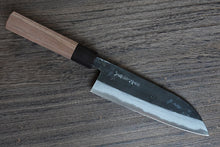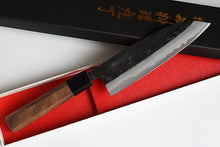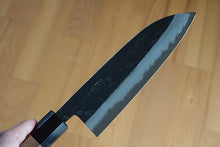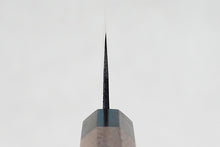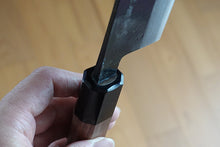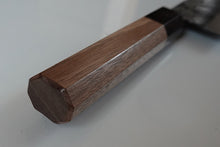
Santoku knife made by the Kajihara blacksmith family, who have inherited traditional knife making techniques for four generations.
The core material is Aogami #2 carbon steel, sandwiched between multiple steels, and shaped by hand forging. The area close to the cutting edge is polished to reveal the laminated steel, while the spine side is left with the black skin created by the forging process. The spine is thick and you can tell at a glance that it is a hand forged knife. This wild and rugged appearance is the unique charm of Tosa region knives.
The blade is made of carbon steel, so it will rust, but it is sharper than a stainless steel knife. And can be made very sharp depending on how you sharpen it.
Material : Aogami#2 steel
Aogami(Blue)#2 is a carbon steel whose quality has been improved by adding chromium and tungsten to Shirogami(white)#2. It is a bit more expensive than Shirogami (white steel). Hard (sharp)and has abrasion resistance (long lasting sharpness), but not stainless steel, so easy to rust. Do not leave wet. Aogami steel is easier to sharpen than stainless steel. To maintain its function, it is recommended to have a sharpening stone.
Type of knife : Santoku
Santoku is a versatile kitchen knife that can cut meat, fish and vegetables. It is the most used kitchen knife in Japan, and it is also the most exported Japanese knife to the Western market. It is easy to handle because it does not have a long blade like a Gyuto knife or Slicer.
Specifications
- Brand : Tosa-Kajiya
- Length : Blade 170mm (6.7inch) , Total Length 300mm (11.8inch)
- Weight : 135grs (4.8oz)
- Blade : Aogami Damascus Carbon Steel
- Hardness : HRC 65
- Handle : Octagonal walnut
- Available for : Right-handed and Left-handed
Maintenance
- Keep clean and dry after use.
- Do not use for any frozen foods or bones.
- Not recommend to clean in dishwasher.
Duties
In addition to the product price and shipping cost, there are cases that your country's customs requests import taxes.






